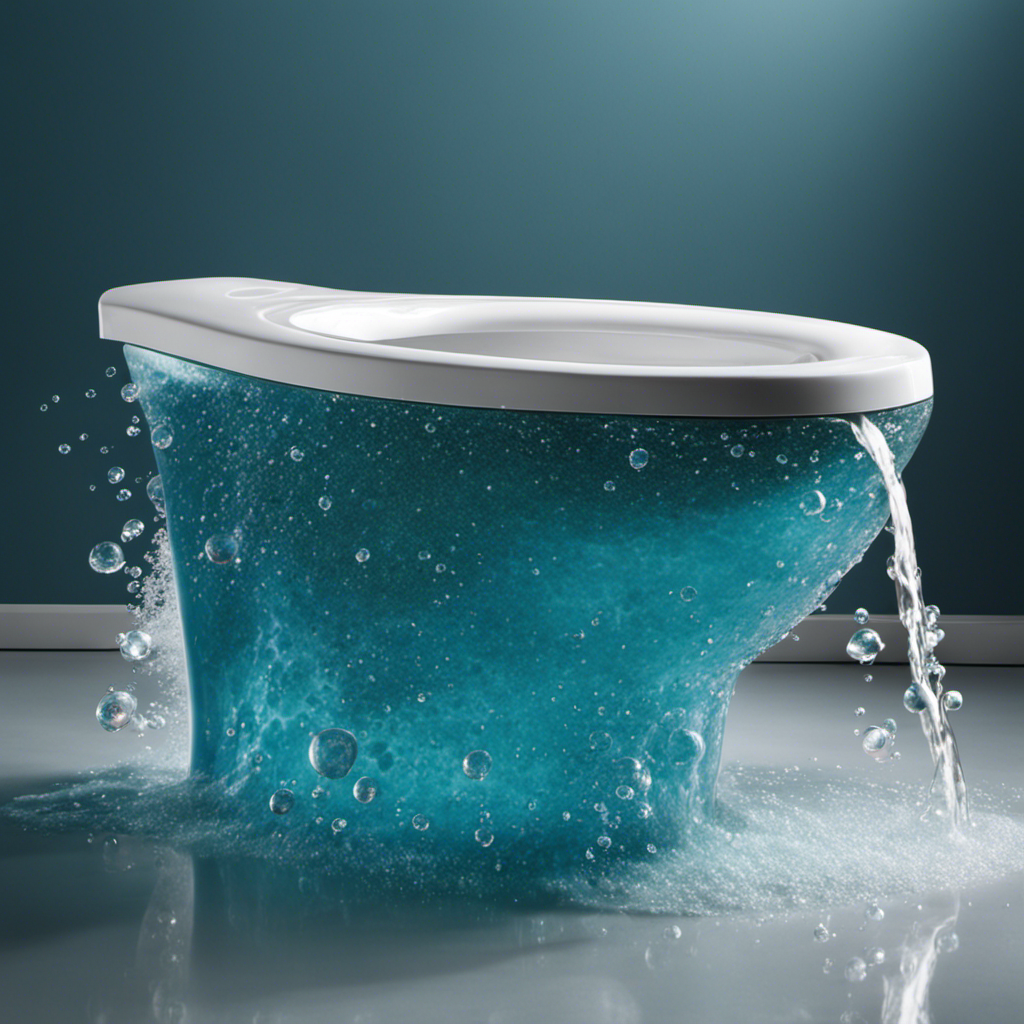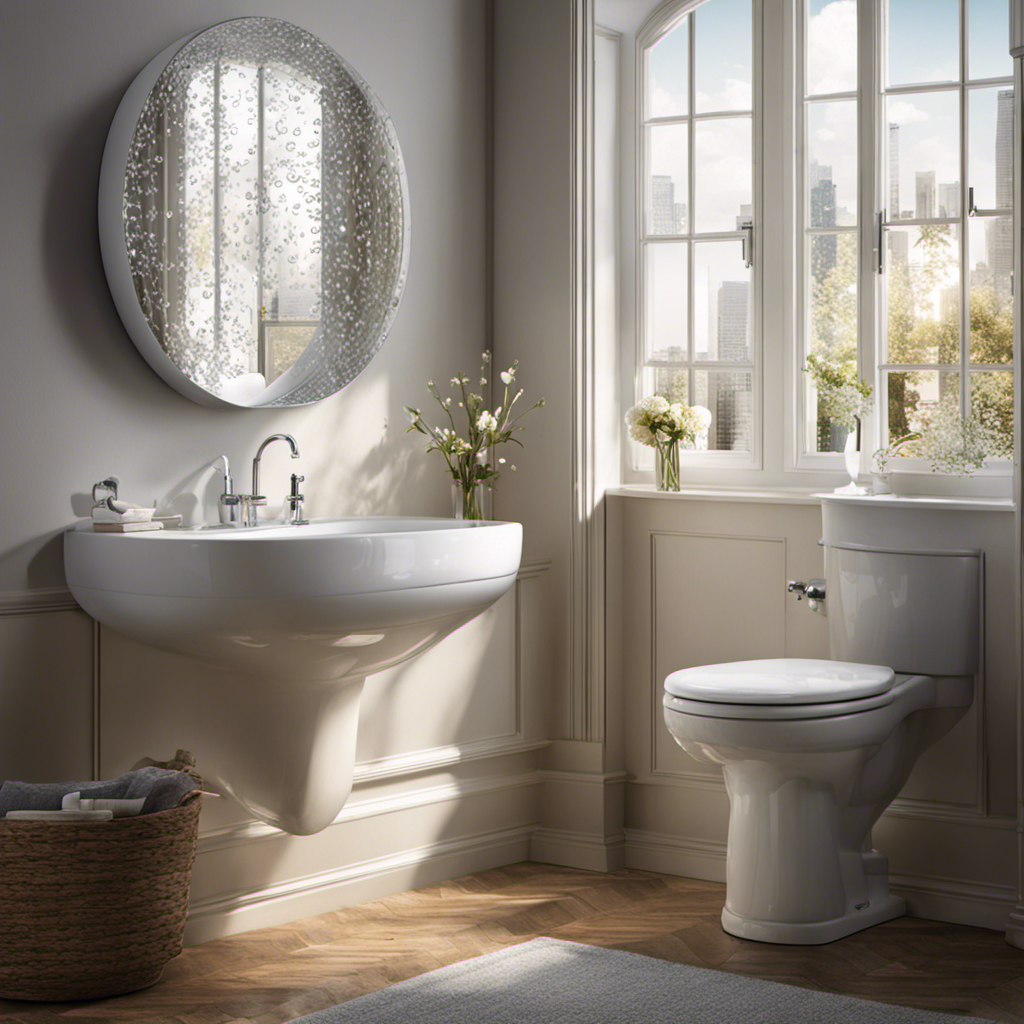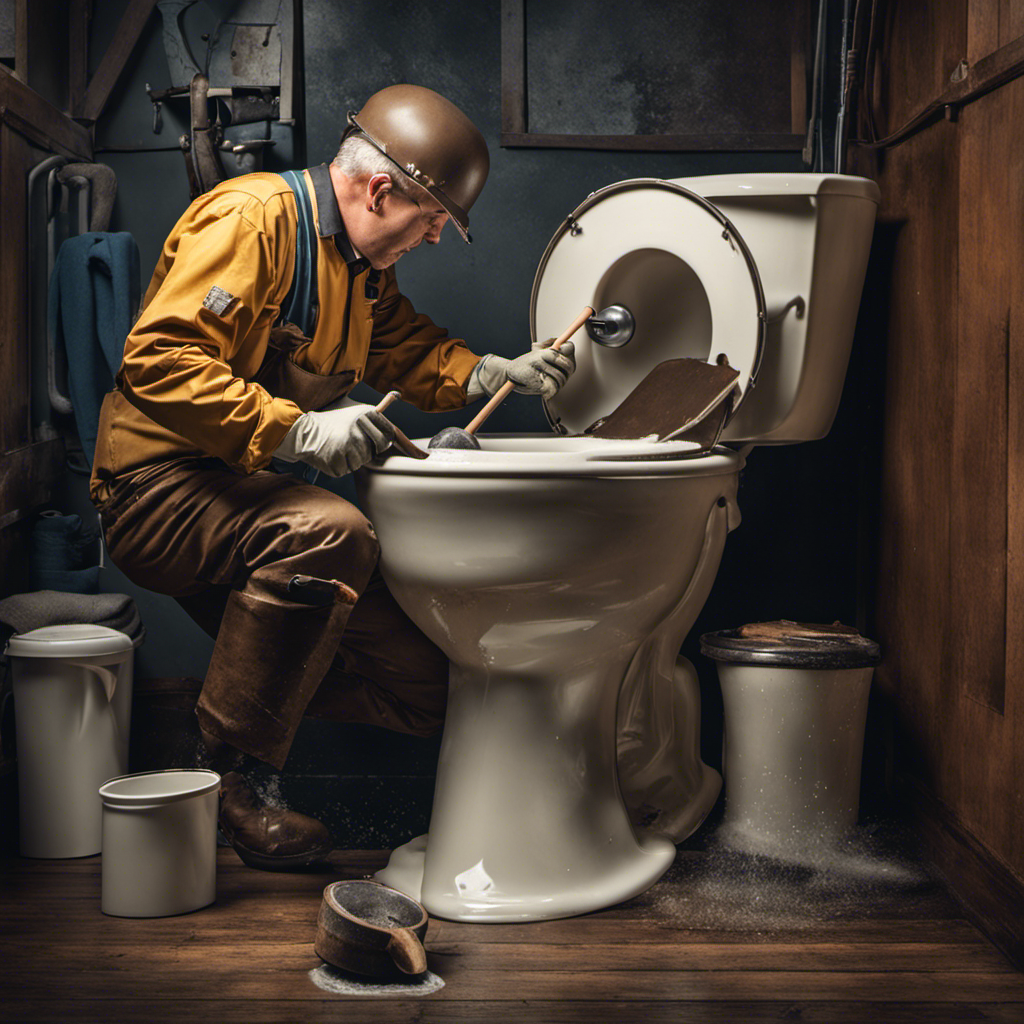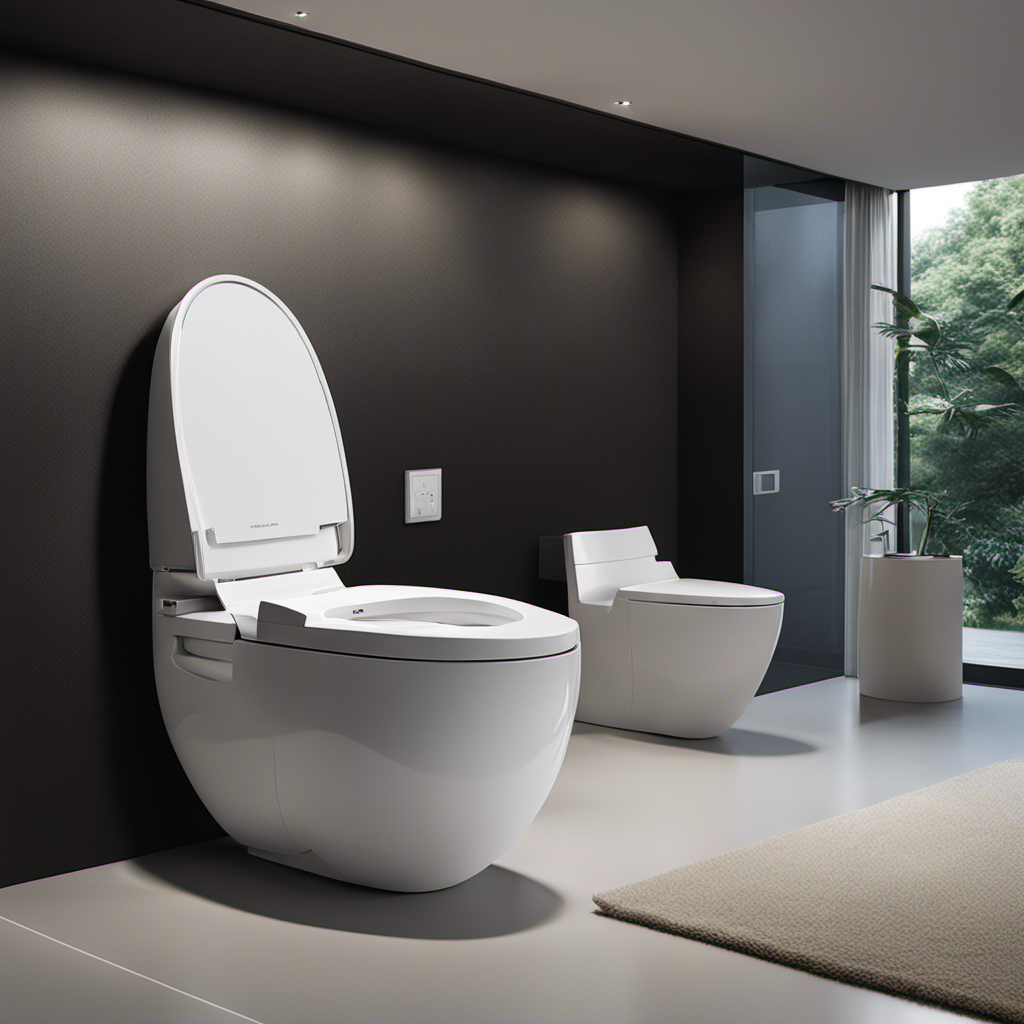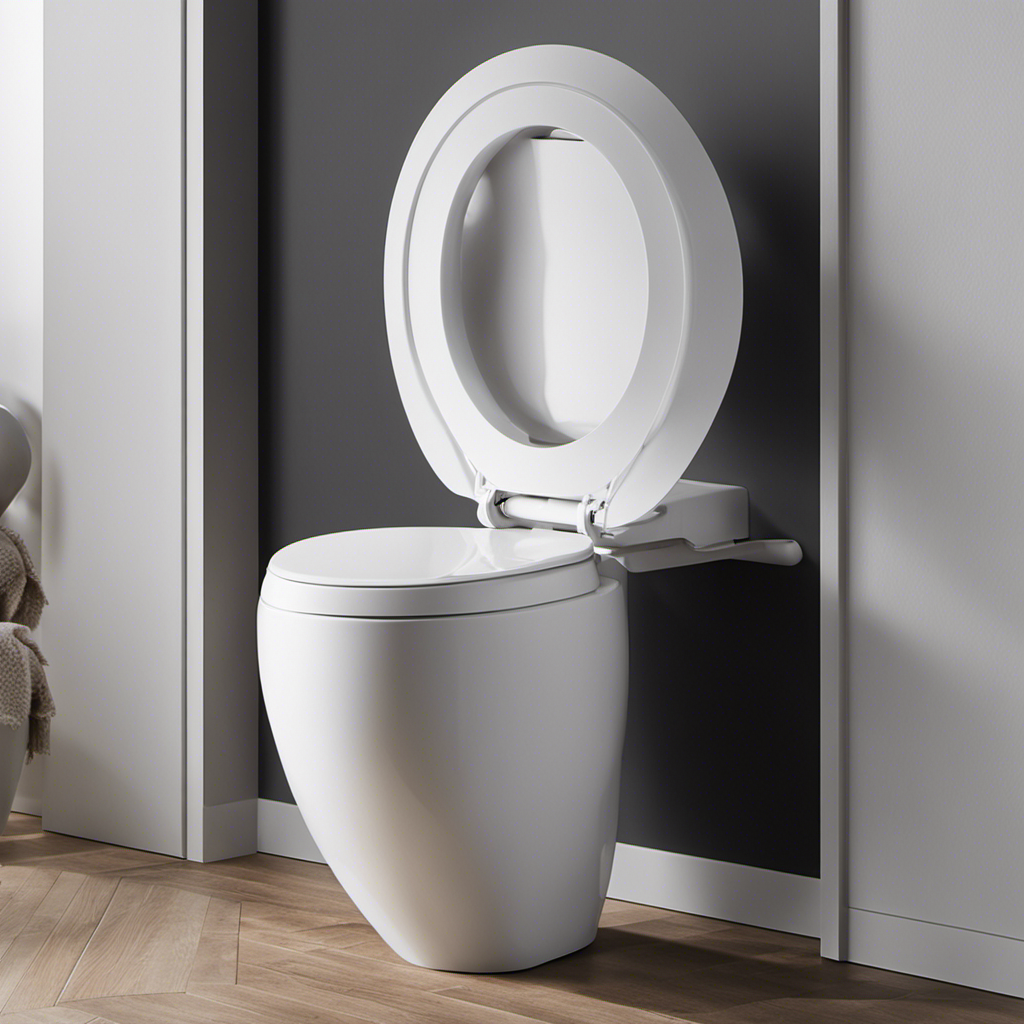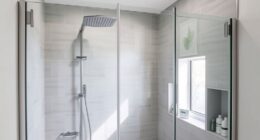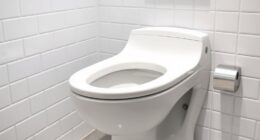You might be frustrated when you flush your toilet and it starts bubbling. But don’t worry, we’ve got you covered.
As a plumbing specialist, I understand the technical aspects of toilet plumbing and can guide you through this issue.
In this article, we will explore the possible causes of toilet bubbling and provide you with clear steps to identify and fix the problem.
So, let’s dive in and tackle this plumbing challenge head-on.
Key Takeaways
- Clogged vent pipes and trapped air in the plumbing system can cause toilet bubbling.
- Plumbing inspections and specialized tools are needed to identify and clear clogs.
- Slow drainage, gurgling sounds, foul odors, and water backing up are signs of a drain blockage.
- Regular plumbing inspections, DIY troubleshooting methods, and preventive measures can help prevent toilet bubbling.
Possible Causes of Toilet Bubbling
One possible cause of your toilet bubbling when you flush it could be a clogged vent pipe. In toilet plumbing, proper venting is crucial for the smooth flow of wastewater.
The vent pipe allows air to enter the plumbing system, preventing airlock and maintaining the balance of pressure. When the vent pipe becomes clogged, the trapped air disrupts the flushing process, causing the toilet to bubble.
To determine if a clogged vent pipe is the issue, a plumbing inspection is necessary. A professional plumber will examine the vent pipe for any blockages or obstructions, using specialized tools and techniques. If a clogged vent pipe is identified, it can be cleared using methods such as snaking or high-pressure water jetting.
Resolving this issue will restore the proper functioning of your toilet.
Now, let’s move on to how to identify a drain blockage.
How to Identify a Drain Blockage
To identify a drain blockage, you can start by checking for slow drainage in sinks or showers. If you notice that water is taking longer than usual to drain, it could be a sign of a clogged drain.
Other symptoms of a drain blockage include gurgling sounds coming from the pipes, foul odors, and water backing up into the sink or shower when you flush the toilet. These signs indicate that there is a restriction in the flow of water, which can lead to further plumbing problems if not addressed promptly.
To determine the cause of the blockage, you may need to inspect the pipes or use specialized tools such as drain cameras. Once you have identified the issue, you can take appropriate steps to clear the blockage, such as using a plunger or calling a professional plumber to perform a more thorough cleaning.
Steps to Fix a Toilet Bubbling Issue
When it comes to a toilet bubbling issue, there are several common causes that could be at play. As a plumbing specialist, it’s important to understand these causes in order to effectively troubleshoot the problem.
In this discussion, we’ll explore the common causes of bubbling, provide DIY troubleshooting methods, and discuss when it’s necessary to seek professional help. By approaching this topic with a problem-solving mindset, we’ll be able to provide practical solutions and recommendations to address the issue effectively.
Common Causes of Bubbling
If your toilet is bubbling when you flush it, one common cause could be a clog in the pipe. Proper drainage system maintenance is essential to prevent such issues. Regular plumbing inspections can help identify potential clogs or blockages in the pipes before they cause bubbling in the toilet.
As a plumbing specialist, I understand the complexities of toilet plumbing. The bubbling can occur when there is a blockage in the vent stack, which disrupts the proper flow of air and water. Additionally, a clog in the sewer line or a faulty sewer vent can also cause bubbling. To resolve this issue, it is recommended to hire a professional plumber who can perform a thorough inspection, identify the cause, and provide appropriate solutions.
Transitioning into the subsequent section about DIY troubleshooting methods, let’s explore some steps you can take to address the bubbling issue on your own.
DIY Troubleshooting Methods
You can try using a plunger to dislodge any potential clogs in the pipes. Sometimes, a simple blockage can cause the toilet to bubble when flushed.
If the plunger doesn’t work, there are a few other DIY troubleshooting steps you can take to identify and resolve the issue:
-
Check the vent stack: A blocked or inadequate vent stack can lead to air pressure imbalances and cause the toilet to bubble. You can try clearing any debris or obstructions from the vent stack using a plumbing snake.
-
Inspect the sewer line: A damaged or clogged sewer line can also cause bubbling. If you suspect this is the issue, it’s best to call a professional plumber to perform a thorough inspection and repair if necessary.
When to Seek Professional Help
It’s best to consult a professional plumber if the problem persists or if you’re unsure. A plumbing specialist has the technical knowledge and expertise to identify and resolve complex toilet plumbing issues. They can accurately assess the signs of toilet damage and determine if there is a sewer line blockage causing the bubbling when flushed. Here are some signs to look out for:
| Signs of Toilet Damage | Signs of Sewer Line Blockage | Troubleshooting Steps |
|---|---|---|
| Cracks in the bowl or tank | Slow draining sinks or showers | Check for clogs in the toilet trap |
| Leaking water around the base | Foul odor in the bathroom | Inspect the sewer line for blockages |
| Constantly running water | Gurgling noises in drains | Consider using a sewer snake or hydro jetting |
Signs of a Ventilation Problem
If you’re experiencing the frustrating issue of your toilet bubbling when flushed, it’s important to understand the causes and find effective solutions to ensure proper ventilation.
One possible cause of bubbling is a clogged or blocked vent pipe, which can disrupt the air flow and create pressure imbalances in the plumbing system.
Another potential cause is a faulty or inadequate venting system, which may not be providing sufficient airflow to prevent the bubbling.
To resolve these ventilation issues, you can start by inspecting and clearing any obstructions in the vent pipe. If necessary, consider installing additional vents or improving the existing ventilation system to ensure proper air circulation.
Causes of Bubbling
When your toilet bubbles, there could be a few different causes for this issue. As a plumbing specialist, let me explain the potential reasons behind this problem in a technical and professional manner. Here are the possible causes:
-
Drainage problems:
-
Blocked sewer line: Obstructions in the sewer line can cause air and pressure to build up, resulting in toilet bubbling.
-
Ventilation issues: Improperly installed or blocked vent pipes can disrupt the airflow and cause the toilet to bubble when flushed.
-
Plumbing issues:
-
Partial clog: A partial blockage in the toilet or drainpipe can lead to air bubbles when the toilet is flushed.
-
Malfunctioning fill valve: If the fill valve is not functioning correctly, it can cause irregular water flow, leading to bubbling.
To troubleshoot and resolve these problems, it is recommended to consult a professional plumber who can accurately diagnose the issue and provide practical solutions.
Solutions for Ventilation
One solution for ventilation issues is to ensure that the vent pipes are properly installed and not blocked. Proper ventilation maintenance is crucial for the effective functioning of your toilet plumbing system.
Ventilation plays a vital role in removing sewer gases and preventing air pressure imbalances that can lead to issues like toilet bubbling when flushed. To ensure proper ventilation, it is important to have vent pipes that are correctly installed and free from any obstructions or blockages. Regular inspection and cleaning of these pipes can help maintain proper airflow and prevent any potential problems.
Benefits of proper ventilation include improved toilet flushing, reduced odors, and prevention of sewer gas buildup. By prioritizing ventilation maintenance, you can ensure the smooth operation of your toilet plumbing system and avoid any inconvenient bubbling issues.
Preventive Measures for Toilet Bubbling
To prevent toilet bubbling, you should regularly clean the drain lines and avoid flushing excessive amounts of toilet paper. This will help maintain proper flow and prevent blockages that can cause bubbling.
Here are some troubleshooting methods for toilet bubbling prevention:
-
Check the vent pipe: Ensure the vent pipe is not clogged with debris or obstructed. A blocked vent pipe can lead to negative pressure and cause the toilet to bubble when flushed.
-
Inspect the drain lines: Look for any signs of clogs or buildup in the drain lines. Use a plumbing snake or auger to clear any obstructions that may be causing the bubbling.
-
Evaluate the water pressure: Low water pressure can contribute to toilet bubbling. Check the water pressure in your home and consider installing a pressure regulator if needed.
Following these preventive measures and troubleshooting steps will help resolve toilet bubbling issues and ensure your plumbing system functions smoothly.
When to Call a Professional Plumber
If you’re experiencing persistent issues with your plumbing system, it’s best to call a professional plumber for assistance. A plumbing specialist has extensive knowledge and expertise in the field of plumbing.
They can explain complex concepts related to toilet plumbing in a clear and concise manner, using technical terminology. Their writing maintains a professional tone, adhering to proper grammar, spelling, and punctuation.
When it comes to a toilet bubbling when flushed, a plumbing specialist would approach the issue with a problem-solving mindset. They would analyze potential causes such as a clogged vent pipe or a blocked sewer line. Troubleshooting steps may include checking for any obstructions or conducting a sewer line inspection.
Based on their experience and qualifications, they would provide practical solutions or recommendations to resolve the problem effectively. Calling a professional plumber is crucial to prevent further damage and ensure the proper functioning of your plumbing system.
Conclusion
In conclusion, if your toilet is bubbling when flushed, it could be caused by a drain blockage or a ventilation problem.
By identifying the issue and following the steps to fix it, you can resolve the problem effectively.
However, it is essential to take preventive measures to avoid future bubbling incidents.
If you are unsure or unable to fix the issue yourself, it is recommended to call a professional plumber who can provide expert assistance.
Remember, addressing plumbing concerns with a problem-solving mindset is crucial for maintaining a well-functioning toilet.
